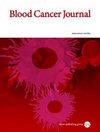Impact of extranodal involvement at CAR T-cell therapy on outcomes in patients with relapsed or refractory large B-cell lymphoma-Results from a multicenter cohort study.
IF 12.9
1区 医学
Q1 HEMATOLOGY
引用次数: 0
Abstract
Extranodal (EN) diffuse large B-cell lymphoma (DLBCL) has been historically associated with inferior survival outcomes compared to nodal DLBCL. However, outcomes of patients with EN DLBCL following chimeric antigen receptor T-cell (CAR-T) therapy are not well established. In this multi-center retrospective cohort study, we evaluated the outcomes of patients with EN DLBCL who underwent CAR-T in the relapsed/refractory (R/R) setting. The primary objective was overall survival (OS), while secondary objectives included progression-free survival (PFS), response rates, and toxicity rates. A total of 218 patients were included in the analysis. The most common sites of EN involvement were skin/soft tissue (25%), bone (22%), and lung (17%). Overall response rate (ORR) and complete response rate (CRR) at first post-treatment evaluation were 62% (n = 127) and 40% (n = 82), respectively. Median follow-up was 3.5 years. Median PFS and OS were 4.0 months (95% CI = 3.1-7.2) and 25.7 months (95% CI = 16.1-51.6), respectively. Cytokine release syndrome (CRS) of any grade occurred in 73% (n = 159) of patients, and 6% (n = 12) had grade ≥ 3 CRS. Immune effector cell-associated neurotoxicity syndrome (ICANS) of any grade occurred in 37% (n = 81) of patients, and 19% (n = 41) developed grade ≥ 3 ICANS. In the multivariable analysis, factors that were independently prognostic of inferior OS were 3 or more lines of therapy prior to CAR-T, bulky disease at the time of CAR-T, hepatobiliary, and pancreas involvement, while refractory disease to the most recent therapy prior to CAR-T was associated with inferior PFS. Future studies should further evaluate outcomes of CAR-T in patients with specific EN sites of involvement that appear to be associated with inferior survival such as the liver and pancreas.CAR - t细胞治疗时淋巴结外受累对复发或难治性大b细胞淋巴瘤患者预后的影响——来自一项多中心队列研究的结果
与结外弥漫性大b细胞淋巴瘤(DLBCL)相比,淋巴结外弥漫性大b细胞淋巴瘤(EN)的生存预后较差。然而,EN DLBCL患者接受嵌合抗原受体t细胞(CAR-T)治疗的结果尚未得到很好的确定。在这项多中心回顾性队列研究中,我们评估了复发/难治性(R/R)环境下接受CAR-T治疗的EN DLBCL患者的预后。主要目标是总生存期(OS),次要目标包括无进展生存期(PFS)、反应率和毒性率。共有218名患者被纳入分析。EN最常见的受累部位是皮肤/软组织(25%)、骨骼(22%)和肺部(17%)。首次治疗后评价总有效率(ORR)为62% (n = 127),完全有效率(CRR)为40% (n = 82)。中位随访时间为3.5年。中位PFS和OS分别为4.0个月(95% CI = 3.1-7.2)和25.7个月(95% CI = 16.1-51.6)。73% (n = 159)的患者出现任何级别的细胞因子释放综合征(CRS), 6% (n = 12)的CRS≥3级。37% (n = 81)的患者发生了任何级别的免疫效应细胞相关神经毒性综合征(ICANS), 19% (n = 41)的患者发生了≥3级的ICANS。在多变量分析中,影响不良OS预后的独立因素是CAR-T治疗前的3条或更多治疗线、CAR-T治疗时的大体积疾病、肝胆和胰腺受累,而CAR-T治疗前最新治疗的难治性疾病与不良PFS相关。未来的研究应该进一步评估CAR-T在特定EN受损伤部位(如肝脏和胰腺)与较差生存率相关的患者中的效果。
本文章由计算机程序翻译,如有差异,请以英文原文为准。
求助全文
约1分钟内获得全文
求助全文
来源期刊

Blood Cancer Journal
ONCOLOGY-
CiteScore
16.70
自引率
2.30%
发文量
153
审稿时长
>12 weeks
期刊介绍:
Blood Cancer Journal is dedicated to publishing high-quality articles related to hematologic malignancies and related disorders. The journal welcomes submissions of original research, reviews, guidelines, and letters that are deemed to have a significant impact in the field. While the journal covers a wide range of topics, it particularly focuses on areas such as:
Preclinical studies of new compounds, especially those that provide mechanistic insights
Clinical trials and observations
Reviews related to new drugs and current management of hematologic malignancies
Novel observations related to new mutations, molecular pathways, and tumor genomics
Blood Cancer Journal offers a forum for expedited publication of novel observations regarding new mutations or altered pathways.
 求助内容:
求助内容: 应助结果提醒方式:
应助结果提醒方式:


